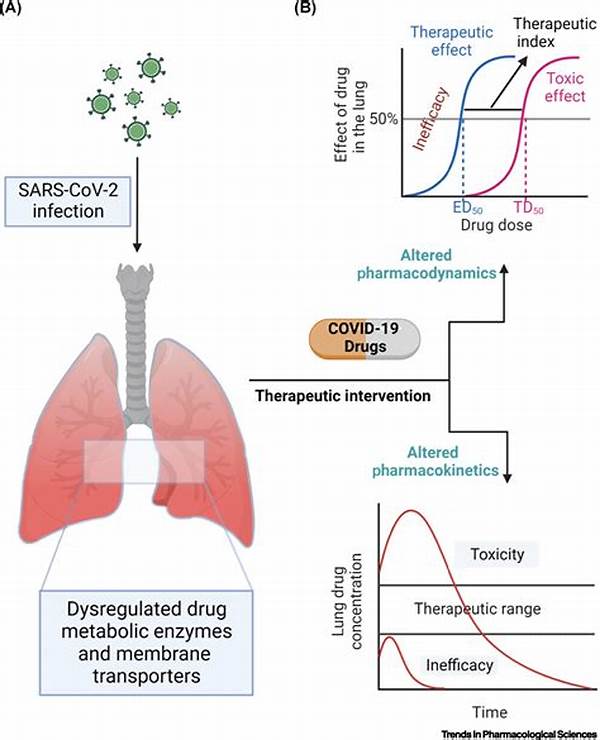In the realm of clinical pharmacology, the concept of dose optimization is pivotal in ensuring the efficacy and safety of medications. Pharmacokinetic factors play a crucial role in dose optimization, as they determine the absorption, distribution, metabolism, and excretion of drugs, collectively known as ADME processes. This article delves into various aspects of pharmacokinetics that facilitate accurate dose adjustments, thereby maximizing therapeutic benefits while minimizing adverse effects.
Read Now : Patient-centered Medication Compliance Strategies
The Role of Pharmacokinetics in Dose Optimization
Pharmacokinetic factors are central to the process of dose optimization. By understanding these factors, healthcare professionals can make informed decisions about administering the appropriate drug dose to a patient. Factors such as bioavailability, half-life, and clearance inform precise dosing regimens, ensuring drugs are present in the bloodstream at therapeutic concentrations. The intersection of these elements is fundamental to achieving a balance between therapeutic efficacy and patient safety. Understanding pharmacokinetic factors in dose optimization empowers clinicians to predict how a drug will behave in the body, adapting doses to meet individual patient needs. Personalized medicine, guided by pharmacokinetic principles, therefore plays a critical role in enhancing patient outcomes through tailored therapeutic strategies.
Key Pharmacokinetic Considerations
1. Bioavailability: Understanding the total proportion of the administered drug that enters the systemic circulation informs dose optimization strategies accordingly.
2. Absorption Rate: The speed at which a drug enters the bloodstream can influence how frequently doses are administered.
3. Volume of Distribution: This factor helps predict how a drug disperses throughout body tissues, crucial for adjusting doses for different body compositions.
4. Half-life: The duration of drug effectiveness, based on its half-life, steers decisions on dosing intervals and ensures sustained therapeutic levels.
5. Clearance: The body’s ability to eliminate a drug impacts both the dose and frequency necessary to maintain therapeutic levels.
Methodological Approaches to Optimize Dosage
Understanding pharmacokinetic factors in dose optimization involves meticulous adherence to established methodologies. Clinicians often employ population pharmacokinetic models that estimate average drug behavior in specified patient groups. These models underpin dose adjustment decisions, especially in specific demographics such as pediatrics and geriatrics. Another strategy involves therapeutic drug monitoring (TDM), which enables real-time analysis of drug concentrations within a patient’s system, facilitating necessary dose modifications tailored to individual physiology. Additionally, pharmacogenomic data assists in understanding genetic variations that predispose patients to altered drug metabolism, paving the way for customized dose regimens.
Understanding Pharmacokinetics: A Slang Perspective
1. Bioavailability: Ain’t about throwing the whole stash in; it’s about what makes it into the bloodstream.
2. Absorption Rate: How fast the drug gets jazzed up in your system.
3. Volume of Distribution: Imagine the drug as Kool-Aid spreading out in a punch bowl.
4. Half-life: How long the effects last before they need a refill.
Read Now : Precise Herbal Intervention Methods
5. Clearance: The system’s cleanup crew doing its job getting rid of the drug.
6. Metabolism: That’s the liver having a party breaking drugs down.
7. Excretion: The way your body shows drugs the exit.
8. Peak Concentration: The high point when the drug is most active in the system.
9. Steady State: When what’s coming in and going out gets groovy and balanced.
10. First-pass Effect: The liver playing traffic cop, directing drug flow.
Implications of Pharmacokinetic Factors in Clinical Settings
Pharmacokinetic factors in dose optimization have significant implications in clinical settings, guiding clinicians in tailoring therapeutic regimens for individual patients. Accurate dose adjustments hinge on considering factors such as absorption rates, half-life, clearance, and bioavailability. These pharmacokinetic parameters enable clinicians to predict and monitor how a drug behaves within a patient’s body, thus ensuring that drugs are delivered safely and effectively. For example, a patient’s renal and hepatic function may alter the drug’s metabolism and excretion, necessitating close monitoring and adjustment of doses to avoid toxicity. In this way, pharmacokinetic factors in dose optimization contribute to safer and more effective patient care by ensuring that therapeutic levels of drugs are maintained, reducing the risk of adverse drug reactions and improving treatment outcomes.
Pharmacokinetic Insights for Personalized Medicine
Within the framework of personalized medicine, pharmacokinetic factors in dose optimization are indispensable for achieving optimal patient outcomes. By precisely assessing factors such as bioavailability and clearance specific to each individual, clinicians can devise personalized dosing strategies that take into account the unique physiological and genetic makeup of patients. This approach minimizes the risks of over- or under-dosing and enhances drug efficacy. The integration of pharmacokinetic factors into routine clinical practice allows for systematic evaluation and adjustment of medication regimens, which is particularly beneficial in managing chronic conditions where long-term medication use is required. Overall, pharmacokinetic factors in dose optimization embody a frontier in precision medicine, offering the potential for enhanced therapeutic efficacy and safety.
Conclusion: Synthesizing Pharmacokinetic Knowledge for Clinical Excellence
In conclusion, pharmacokinetic factors in dose optimization serve as critical determinants in the realm of therapeutic efficacy and safety. By integrating knowledge of ADME processes into clinical strategies, healthcare professionals are equipped to tailor pharmacotherapy regimens that account for individual variability in drug response. This alignment between pharmacokinetics and personalized medicine underscores the ongoing evolution in patient-centered care. As advancements in pharmacokinetic research continue to unfold, their application in the clinical setting promises to refine dosing precision further and enhance patient outcomes. The continued collaboration among clinicians, pharmacologists, and researchers is essential in perpetuating advancements that harness pharmacokinetic factors in dose optimization for the betterment of patient care worldwide.
